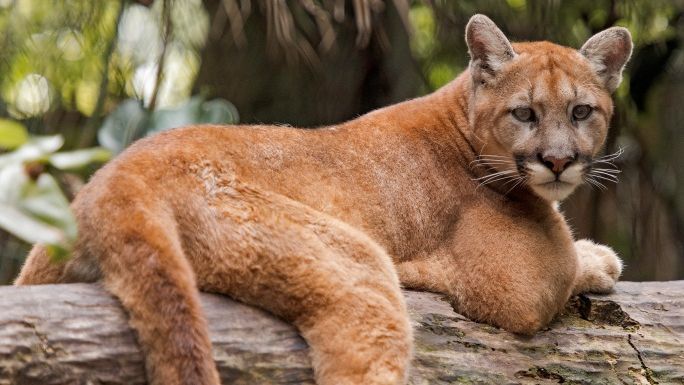It’s been 600 years since William Shakespeare famously asked, “What’s in a name?”
Here in 2023, we’re still wondering the same thing — not about Romeo and Juliet of course, but about the Florida Panthers.
More specifically, the Florida Panthers’ mascot.
Is it an actual panther emblazoned on the team’s sweater? Or a panther in name only? And what’s the difference between it and other big cats?
While Florida gears up to face the Vegas Golden Knights in Game 2 of the Stanley Cup Final, the feline frenzy has been a topic online during the team’s improbable run in the Stanley Cup playoffs.
The Panthers’ social media team even tweeted a link from the University of Florida’s Wildlife, Ecology and Conservation to help explain what their cat really looks like.
“Panthers can sometimes be confused with bobcats, dogs, and coyotes,” the team tweeted, citing the report.
Let’s start at the beginning.
The Panthers’ primary mascot is Stanley C. Panther, named in 1995 by then-five-year-old Darrel Ambrosini. The moniker is firstly a reference to the piece of hardware Florida is currently four wins away from hoisting for the first time in team history.
The design itself is of an anthropomorphic version of the endangered cat, an acknowledgement of the state’s official animal, the wildlife population and the fierceness of the beast itself.
But, is a panther really a panther? The answer is … complex.
“A panther is absolutely the same thing as a puma, or a mountain lion. They are all the same animal,” Dr. Mark Elbroch, director of the puma program at Panthera — a global science and conservation organization for wildcats — told ESPN. Elbroch has spent more than two decades studying big cats. “It is the species listed as holding the world record for most names. The Florida panther is not only the exact same animal but the exact same subspecies as the ones in Idaho and Washington State and California, and all of Mexico. So, it’s just a name thing.”
Elbroch said the big cats’ incredible geographical range — from central Canada all the way down through South America — is how a single animal earns several different titles.
“In Florida, if you don’t say the word ‘Florida panther’ people may not know what you’re talking about,” Elbroch said. “Whereas in Washington, everyone says cougar; in Wyoming, everyone says mountain lion. And if you don’t use the local lingo, people look at you funny and identify you as an outsider immediately.”
While the Florida panther, which weighs between 80-130 pounds, might share a name with other cats — Elbroch estimates there were at one time 28 different species of mountain lion — Florida’s version does boast a unique history. They were the only cats east of the Plains that miraculously survived an onslaught of European settlements and were able to recover from only 20 remaining to over 200 now, a “remarkable” increase according to Elbroch.
The panther stayed alive by burrowing into South Florida’s mosquito-infested swamps and “hung on there,” said Elbroch. Pinelands and wetlands around Everglades National Park and Big Cypress National Preserve are where the panther continues to hunker down, in a place where few humans — or real estate developers — are able to disturb them.
Such tenacity of spirit could certainly lend itself to making the panther an appropriately dominating symbol in the sports world. From a scientific perspective though, Elbroch can’t help but point out the panther isn’t exactly the communal type.
“The panther is an odd choice for a team as an emblem because mountain lions’ function most of the time alone in terms of hunting,” he said. “The African lion, for example, defends the family collectively. But the panther is more solitary. They are not an aggressive animal, which is something that maybe teams don’t quite realize — unless they’re threatened. And then of course, you’re going to see their teeth and claws.”
That could actually be a perfectly fitting analogy for this iteration of the Florida Panthers’ entire season. The Ice Cats looked tame early on in a lean year spent mostly out of playoff contention. It wasn’t until their late surge into the Eastern Conference’s final postseason slot that Florida started to show some grit. That evolved into the Panthers becoming this postseason behemoth, tackling all comers en route to a resoundingly unpredicted Stanley Cup Final berth.
It’s a trajectory the Panthers share with (all manner of) their feline counterparts.
“They’re fiercely independent, amazingly strong, agile [cats]. I consider the panther sort of that quiet, cautious personality in the background,” Elbroch said. “They love to watch, they love to observe, and you’re only going to see the sort of teeth and claws if you corner them. And then, of course, they’re going to fight for their life.”
So, what is in a name?
Should the Florida Panthers really be the Florida Cougars? Or Florida Mountain Lions?
And why, exactly, are there so many titles for such similar beasts?
Perhaps we take a page from Shakespeare and question why we need to name things at all? Like the panthers themselves, simply let the Florida Panthers run free in their natural habitat.
“I think people have always been in love with the grace and strength of big cats,” said Elbroch. “A mountain lion can take down prey that weighs 10 times their weight; that’s essentially superhuman power. Sports teams want to emulate that kind of strength, right? A big cat is a survivor. They’re incredibly resilient. They’re strong. And they have the weaponry to protect themselves.”
